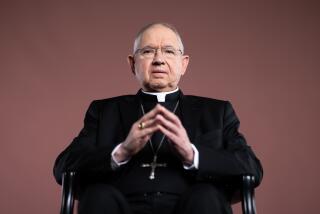Msgr. George Higgins, 86; Backed Workers Rights
- Share via
Msgr. George G. Higgins, a principal draftsman of modern-day Catholic social theory who was called “the labor movement’s parish priest,” has died. He was 86.
Higgins died Wednesday at his sister’s home in La Grange Park, Ill., of complications from an infection.
For several decades, Higgins was considered the leading intellectual in the U.S. Catholic Church’s links to 20th century trade unionism, immigrant advocacy and liberal social policy.
“There is no one in the United States who has had the singular impact he has had on the Catholic Church and social teaching in the last half century,” said the Rev. Brian Hehir, former dean of Harvard Divinity School.
Higgins was a close confidant of virtually every major labor leader since the 1940s, including John Brophy, George Meany, Walter Reuther and John Sweeney, the current AFL-CIO president.
Higgins served on the staff of the Washington-based National Catholic Welfare Conference, now the U.S. Conference of Catholic Bishops, from 1944 until retiring as secretary for special concerns in 1980. He was director of the conference’s influential social action department from 1954 to 1967.
He had, since his early priesthood, established himself as a sought-after economics and labor expert at a time during the Cold War when religious figures played bigger roles in public life and industrial relations were the vexing question of the U.S. economy.
“More than any other American in the 20th century, Msgr. Higgins argued that Christian beliefs must prominently include the notion that work must be valued and workers honored,” Sweeney said in a statement Wednesday.
Higgins served from the 1960s to 2001 as chairman of the United Auto Workers Public Review Board. He helped defuse a steelworkers action that threatened major disruption to the economy in the 1950s. In the late 1990s, he was a champion of janitors organizing in Los Angeles.
What he called one of his most satisfying efforts, however, was the political success in the late 1960s and early ‘70s of Cesar Chavez and the United Farm Workers. The determined priest cemented the relationship between the Catholic Church and the workers.
Throughout it all, he called on laypeople to support unions and aggressive social policy, armoring himself with the church’s own teachings, especially two foundational papal encyclicals that endorsed workers’ rights, Rerum Novarum (1891) and Quadragesimo Anno (1931).
Higgins made enemies when he argued against the reticence of major labor groups to admit minorities and railed against corruption in the manner of an “On the Waterfront” priest. He also fought a rear-guard action against the Teamsters in his advocacy of the United Farm Workers.
He described his career as one of a “ministry of presence,” and himself as a “social-action bureaucrat.”
Higgins also was a key figure seeking to mend the rift between Jews and Catholics. He was influential in removing a reference to “perfidious Jews” from the Catholic Good Friday Mass.
As a media spokesman and consultor for U.S. bishops based in Rome in the early 1960s, he was prominent in framing and explaining to American Catholics the significance of the landmark reforms of the Second Vatican Council.
“Much of what the world press reported about the council filtered through George’s clean and succinct prose,” the Rev. Andrew Greeley wrote in a recent appreciation.
Much of Higgins’ sway stemmed from his weekly column, “The Yard Stick,” which he took over from another one of his mentors, the Rev. Raymond A. McGowan, in 1945. He continued writing until recently, though his eyesight had been failing for years. The column, noted for its steel-clean writing and contrarianism, was syndicated in hundreds of diocesan newspapers and often was a lone liberal voice amid a sea of conservative Catholic commentary.
Higgins began his social education during lunch breaks from parochial school as a 10-year-old at his kitchen table in his native La Grange, Ill. There, his father, a night postal foreman and union supporter, would have him read aloud from the liberal Catholic journals Commonweal and America. As a child, his father also would take him on regular visits to Jewish neighborhoods on Chicago’s Near West Side.
Higgins later would attend the Chicago Archdiocese’s St. Mary of the Lake Seminary and would come to the attention of another legendary activist priest, Reynold Hillenbrand, the seminary rector who inspired an impressive crop of social-minded clerics in that period.
Upon his ordination in 1940, Higgins was sent to Washington to study at Catholic University, where he completed a doctorate in economics in 1944. Higgins would be associated with Catholic University as a teacher and lecturer for several decades. Though he was assigned to the Chicago Archdiocese, Higgins found a way to stay on in Washington, after accepting what was to be a temporary appointment at the bishops conference. He ended up staying 36 years.
Higgins was looked upon as radical for his talk about minorities and as “dinosaurian” by others for his support of the union movement. He parted with liberals on the issue of abortion, which he denounced. And he tweaked members of the church hierarchy on the issue of the rights of workers at Catholic institutions to organize.
In later years, Higgins expressed frustration at the declining influence of unions within the Catholic Church, and vice versa, blaming the diminution on the increased affluence of Catholics. He was awarded the Medal of Freedom, the nation’s highest civilian honor, by President Clinton in 2000.
Higgins is survived by two sisters.
More to Read
Get the L.A. Times Politics newsletter
Deeply reported insights into legislation, politics and policy from Sacramento, Washington and beyond. In your inbox twice per week.
You may occasionally receive promotional content from the Los Angeles Times.










